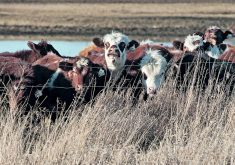Glacier FarmMedia — Saskatchewan Agriculture is asking cattle producers to be on the lookout for anthrax after infections from the bacterial disease caused cattle loss in the northwestern region of the province.
Lab results have confirmed anthrax as the cause of livestock death in the Rural Municipality of Paynton, northwest of North Battleford, according to a May 13 release.
Anthrax is caused by the spore-forming bacteria Bacillus anthracis. The pathogen can survive in spore form in soil for decades while changes in soil moisture, either flooding or drying, can spur a buildup of spores on pastures.
Read Also

Selling GMO tomato seeds to Canadian gardeners ‘reckless’ say advocates
Selling genetically-modified purple tomato seeds to home gardeners could raise the risk of contamination of organic vegetable varieties and hamper farmers’ ability to save their own seed, say a group of advocates.
The May 13 release noted that spores can concentrate in sloughs and potholes. The risk of animal exposure rises when such areas dry up and become accessible to livestock. Excavated ground and excessive run-off can also cause spores to surface.
Livestock are infected when they eat forage contaminated with spores. Ruminants such as bison, cattle, sheep and goats are highly susceptible. Horses can also be infected.
Swine, birds and carnivores are more resistant, but farm dogs and cats should be kept away from carcasses, the ministry warned.
It can, however, be prevented with vaccination, and the Saskatchewan government urges farmers in areas with a history of anthrax to vaccinate their herds annually.
“If your neighbours have anthrax, you should consider vaccination to protect your animals,” the release said.
Animals killed by anthrax are usually found without any signs they were sick, the agriculture ministry said.
Anyone who suspects anthrax is urged to immediately contact their veterinarian. Diagnosis must be confirmed by a lab test, and positive results must be reported to the provincial chief veterinary officer right away.
The ministry is also asking producers to be cautious when handling potentially infected animals or carcasses. If a carcass is suspected of carrying anthrax, it should not be moved or disturbed, the release warned. The remains should also be protected from scavengers such as coyotes or ravens.
The ministry says that animal anthrax cases present minimal risk to humans, but people can become infected through direct contact with sick animals or carcasses. Those who believe they have been exposed should contact their local health authority or doctor.
















